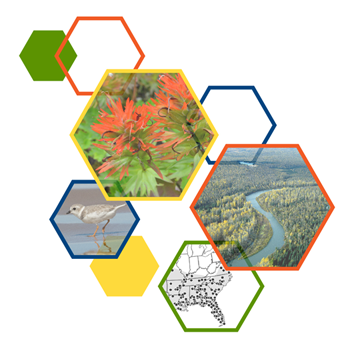 As pressures on biodiversity increase, there is an increasing need for rapid and more comprehensive biodiversity assessments and an increasing volume of observation data available from citizen science and other data collection efforts across the globe. To meet this need NatureServe developed a standard for collecting and compiling biodiversity observation data across the Network and from external sources.
As pressures on biodiversity increase, there is an increasing need for rapid and more comprehensive biodiversity assessments and an increasing volume of observation data available from citizen science and other data collection efforts across the globe. To meet this need NatureServe developed a standard for collecting and compiling biodiversity observation data across the Network and from external sources.
The Biodiversity Observation Data Standard addresses two key objectives:
- It provides a comprehensive set of fields that are relevant to most Network programs and meet individual program needs for collection and management of observation data.
- It identifies subset of core biodiversity observation data fields that can be used to aggregate data in support of key Network-wide products:
- Spatial biodiversity distribution products (including element occurrences, range maps, hexagon grid-observations, and habitat suitability models)
- Conservation status assessments
- Quality/condition assessments of at-risk species and ecosystems.
The Biodiversity Observation Data Standard contains a comprehensive list of 166 fields for use by Network programs to collect and manage biodiversity observation data. Fields that are directly equivalent to Darwin Core are noted. The Standard identifies the subset of fields required to create a basic observation, a larger subset that will support the generation of core network products and additional fields that are needed to import observation data from external sources.
The Biodiversity Observation Data Standard places NatureServe and the Network in a better position to place the most current, complete, and consistent biodiversity data into the hands of researchers and decision makers. It will facilitate the use of observations collected by sources such as GBIF and GeoBON, other partner organizations, as well as citizen scientist efforts like eBird, and iNaturalist. It will also standardize and leverage Network data by facilitating the creation of a wide range of products beyond that of Element Occurrences, including inputs to habitat suitability models, gridded occurrence or hotspot maps, and species and ecosystem conservation status and condition assessments.
The standard is designed to a) effectively manage observation data at the individual program level, b) support the key network products, and c) maximize compatibility with Darwin Core to aid the use of data from other sources. A series of apps, tools, and protocols based on the standard have been developed to facilitate the collection and aggregation of observation data and the creation of key products.
